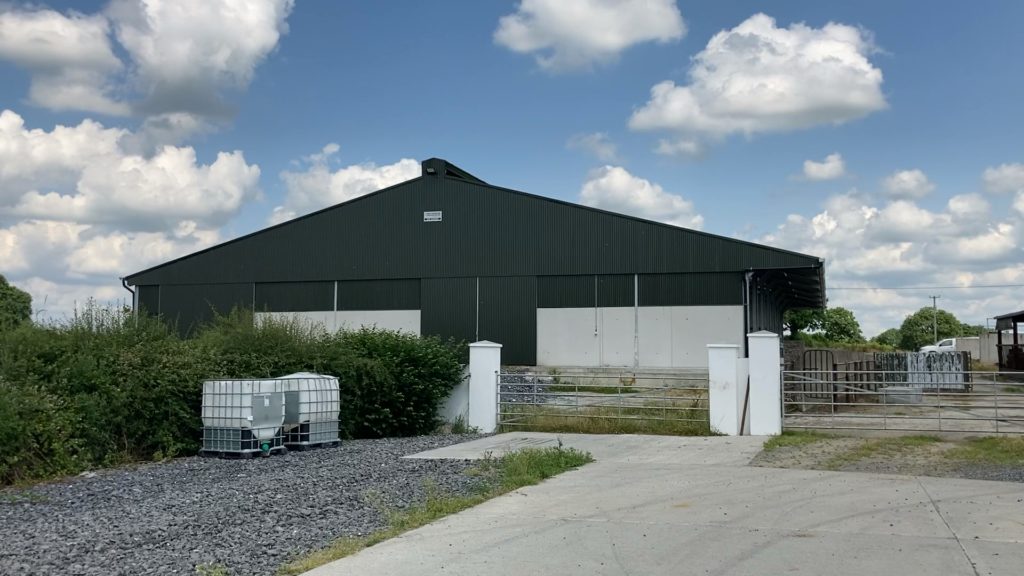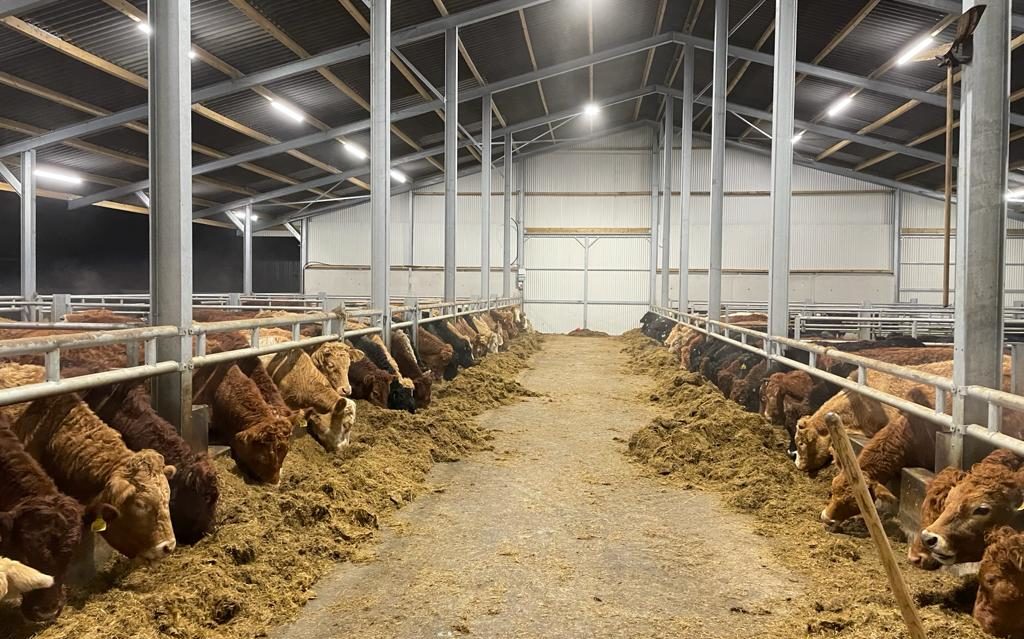The last of our Back In Focus series takes us to Ballymahon in Co. Longford where farmer and businessman Michael Delaney has built a new beef unit on his farm.
The Longford native took over the farm from his late father just over five years ago, and has since put his own stamp on the farm and, although he still continues using some of his father’s methods, he has gone down the route of rearing and supplying his own beef for his recently opened sit-in takeaway restaurant in Ballymahon – called Jolly Boys.
Therefore, in order to run the new food business, his already established Midland Lighting company and the farm – he had to look at making the farm more efficient to run and to try and cut down on labour.
So in order to streamline the farm, Michael went about building winter accommodation that would allow him to house nearly all his cattle under the one roof, rather than having cattle in five/six different sheds dotted around the farm.

Speaking to Agriland about how the farm has evolved since he took it over from his father and how his new finishing unit will help make running the farm more efficient, Michael said: “I took over the farm from my late father over five years ago and back then, my father used to finish continental cattle.
“However, there was no real money being made from this system, so I looked at my options and there late last year, myself and a few friends opened up a local dine-in takeaway in Ballymahon.
“I said to the lads, ‘look what’s the point buying in beef when I can produce it myself’ – literally just out the road from the takeaway.
“It’s nice to say that the beef is locally produced and some of the grain we feed the cattle to finish them off is also sourced locally [from Wide Street Brewing Company, in Ballymahon] as well – so it’s a nice story to tell and with the farm making no real money before this, it’s now in a much better place, financially.
“I still keep continental cattle and will probably look to sell them as forward stores rather than fattening and killing them in the factory. While the beef for the burgers for the takeaway comes from Hereford-cross cattle I have on the farm.
“The new shed that we are looking at here then ties the whole farm together nicely because before we had it, we had cattle in five/six different sheds and it was just a bit all over the place.
“The new shed allows me to house all the cattle under the one roof and just makes feeding cattle over the winter more efficient and easier to do.”

Design of the new unit
Having looked around at other beef units on other farms, Michael was able to nick a few ideas and put down on paper what he wanted for his farm.
He got the help of Brendan Quaine who drew up the plans of the shed, along with his advisor, John Coyle.Also Read: Buildings Focus: Leaving no stone unturned in this new suckler unit in Roscommon
The beef unit is a six-bay double, double. It can fit the guts of 220 cattle, according to Michael.
Looking at the dimensions of the unit, the six-bay double shed is 7.725m high at the apex and 3.5m high to the eve gutters. It is 28.9m long and 28.0m wide. The concrete walls of the shed stand 2.4m high.

Altogether, there are 12 slatted pens. Six either side of the central feeding passageway.
To increase the number of cattle that could fit in the shed, Michael opted to put in double tanks on both sides of the shed.
This means that each slatted pen measures just shy of 8.5m wide and are 4.8m long. The tanks are 2.4m deep.
To facilitate being able to fit more cattle into the shed, not only were the pens made bigger, but feed space was made available on either side of the pens.
So, there are three feeding passageways. One in the middle of the shed, which measures 4.81m wide, while the other two, on the outer side of the pens, measure 2.5m and 6.1m wide respectively.

The passageway measuring 2.5 wide is not roofed, instead, a canopy protrudes over it. While the other outer feed passageway, measuring 6.1m is in fact roofed and can be used as a bedded lying space for cattle. At the moment, it is used to store straw.
The reason for having the three passageways and having sliding doors at either end of the shed was to be able to allow for a diet feeder to be used in time.

Taking a closer look inside
As already mentioned, Michael took a look at other beef units to see could he pull some ideas from them to implement in his own shed.
As mentioned, there are 12 slatted pens in the shed, with the option of creating a further six at the back of the unit as a dry bedded area.
One side of the shed is used to house stock close to finishing, while the other side is used for younger stock.

In order to accommodate stock of different ages, the height of the feed barriers can be adjusted (as seen below).
At the front of the pens and also at the back of the pens that lead into the dry-bedded area/feeding passageway are small access gates. Again, to make as much feed space as possible, these small gates can also be used as feed space (as seen below).

Due to the sheer size of the shed and the number of cattle that are in it during the winter months, plenty of space for air to flow in and out of the shed was incorporated.
Air can flow in and out of the shed; at the apex, at the back where a gap is left between the ventilated galvanised sheeting and the eves, and while the outer feed passageway is open and not roofed, four sliding doors were also fitted and can be left open to further enhance the airflow in and out of the shed.

One of the ideas Michael nicked from going around to other farms was creating a holder on two of the girders to hang his fork/sprong and hand scraper (seen below).

‘I told the contractor to leave the agitator at home’
Michael said the farm has never been ‘machinery mad’, so he looked at ways to cut down on the use of machinery coming on the farm to carry out work, and to cut costs to again, make the farm as efficient as possible.
One way which he felt could cut back on this and costs, was by installing a Smart Slurry Aeration System from Dairypower Equipment.
Speaking about this system, Michael said: “Most farmers are looking for contractors to come in with the agitator in the new year so instead of having to wait around, we decided to put in a slurry aeration system.
“So far, we have found it a great job. The contractor was having his doubts the day he came in to take away the slurry. He was saying ‘are you sure I won’t go for the agitator?’
“I said no, just come with the tanker. With the system, the slurry never settles and no crust forms – so you don’t have those dangerous gases building up.
“It’s just much safer for both man and beast in my opinion and there’s always spreadable slurry available.”

Who was involved in the build and what was the cost of it?
Local man, Brendan Quaine designed the shed for Michael. Kevin Sullivan carried out the concrete work, while the slats were sourced from Mulleady’s Longford Precast.
Newtowngore Engineering erected the shed, made and stood all the gates, feeding barriers and water drinkers.
All the electrical work was done by F. White Electrical, with the waterproof lights coming from Michael’s own business, Midland Lighting. While the finishing touches, such as the hangers for the tools and door protectors was carried out by Fabworx Ltd.

The fact Michael is in partnership with his mother, they decided to apply for a grant under the Targeted Agricultural Modernisation Scheme (TAMS II).
Having been awarded a grant, it took a chunk off the cost of what Michael had to pay out of his own pocket.
The overall cost of the build came to €230,000 including VAT. The project took the guts of two years going back to initial planning to complete, with the construction process taking about a year.

Speaking about the decision to go ahead and build the new shed, Michael said: “I just had to bite the bullet and go for it.
“Cutting down on labour and streamlining the farm were the goals and after our first winter in the shed, it has really cut down on the time spent feeding cattle.
“I’d just like to credit everyone involved in the build. It turned out exactly how I wanted it and now I can look forward to making other improvements around the farm,” Michael concluded by saying.

